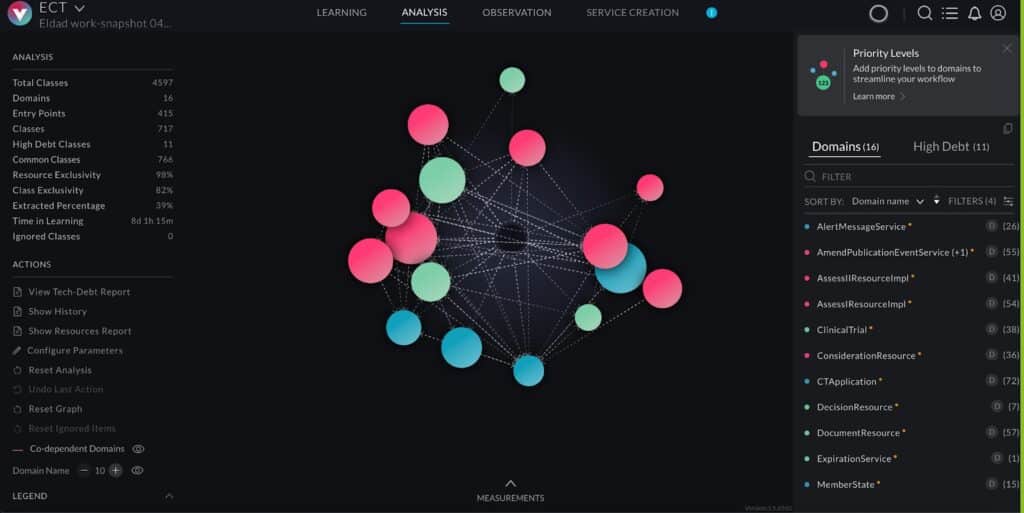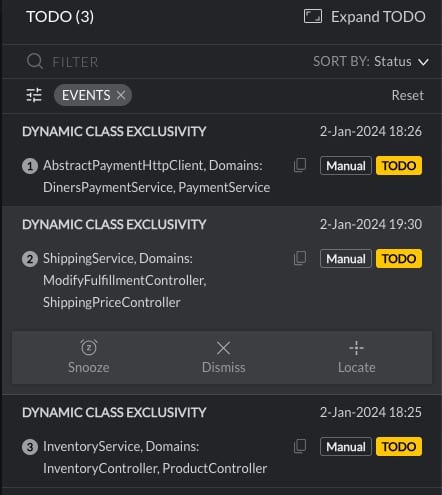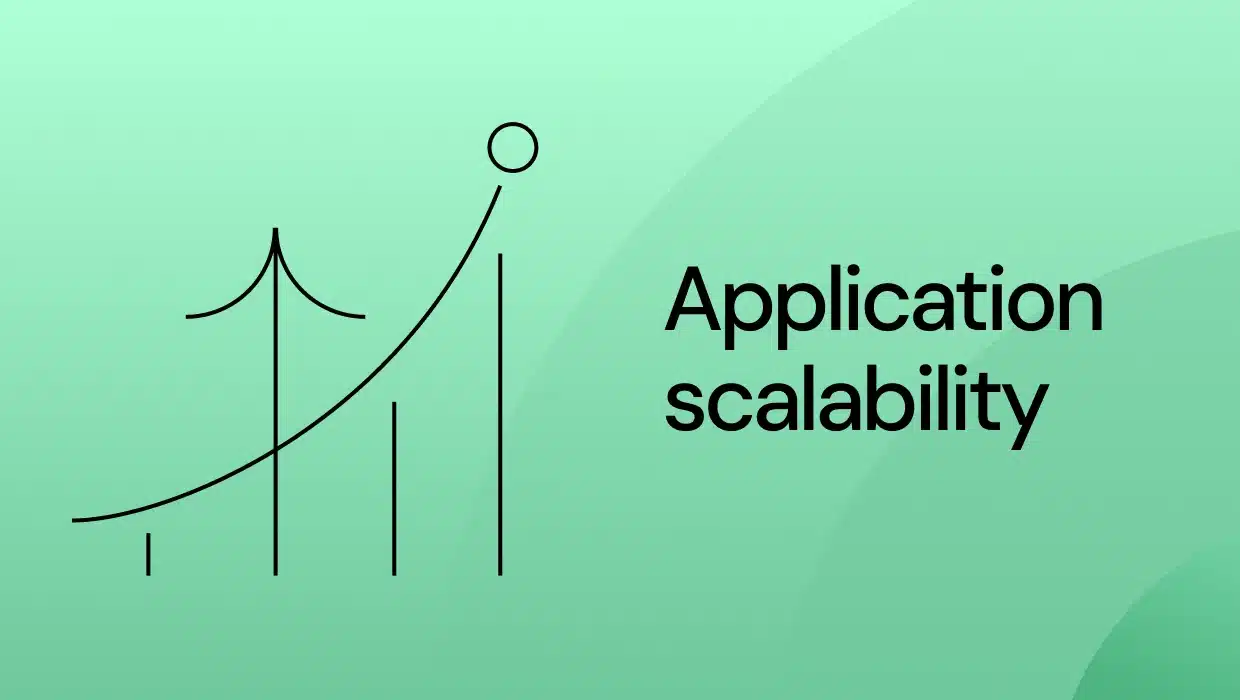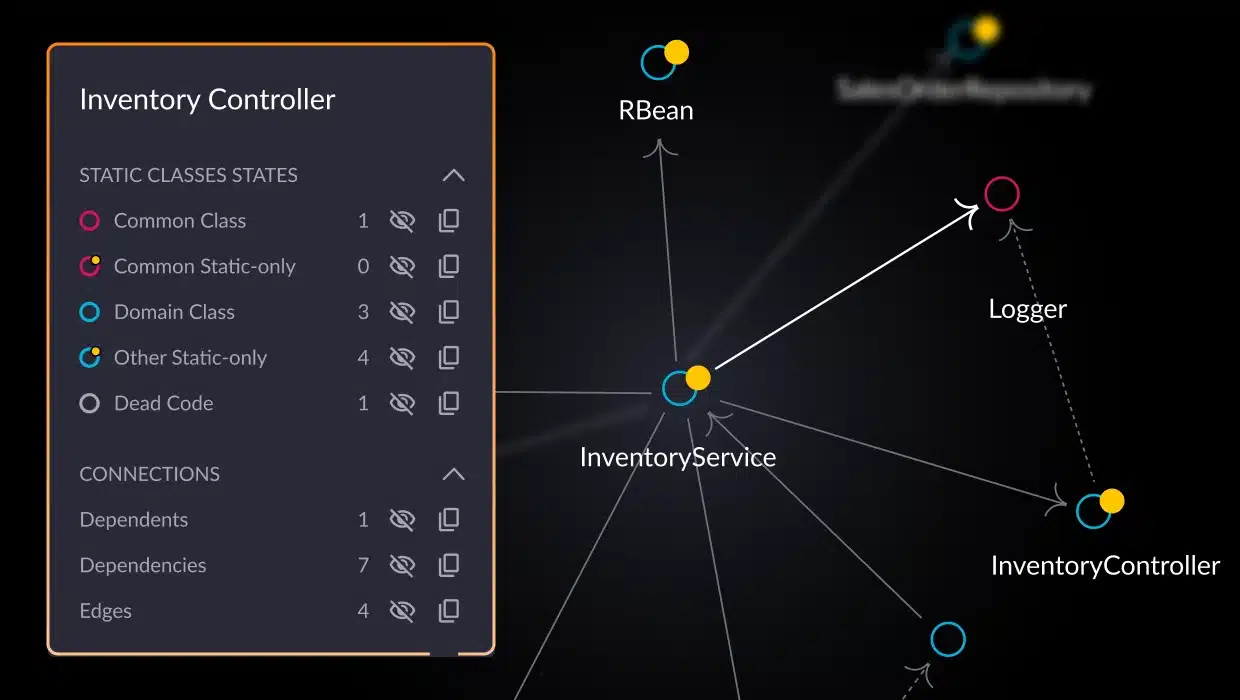As you build applications and welcome users in the door, at some point, you may find that the user load is bogging down the application. At the same time, the users’ expectations of how the app should perform means that building applications that simply “work” isn’t enough. As traffic increases, the application must be able to scale to meet user demand. Application scalability is the component within your design and implementation that allows your software to handle increased loads gracefully, maintain lightning-fast performance, and ensure rock-solid reliability as demand grows.
In this blog post, we’ll explore the key strategies, best practices, and challenges of achieving application scalability. We’ll also discuss different types of scalability, the factors that influence it, and how you can leverage tools like vFunction to simplify your scalability journey. Let’s begin by exploring what application scalability is.
What is application scalability?

When we talk about application scalability, in its simplest form, we are talking about the ability of a software application to handle a growing amount of work. This “work” could be many different things but usually involves one of these three factors:
- Increased user traffic: Imagine your app suddenly having an uptick in users. Can it accommodate a surge in users without slowing down or crashing?
- Higher data volume: As your app matures, it likely accumulates more data. Can it still retrieve and process information efficiently?
- More complex operations: As your app matures, new features will stress its architecture in unintended ways. What happens if users perform more intricate tasks within your app? Will it remain responsive?
If your application can adapt to these changes smoothly while maintaining performance, responsiveness, and reliability, then it’s considered scalable.
It also makes sense to note that scalability is different from performance. A high-performance application might be blazing fast for a single user, but it’s not scalable if it can’t handle multiple concurrent users. Scalability is about ensuring that performance remains consistent even as the workload grows.
Why is scalability important?
Scalability is fundamental for any application aiming for long-term success. It touches many areas of the business, for better or worse. Let’s examine why scalability is important for modern applications and users.
User satisfaction and retention
Users have little patience for slow or unresponsive applications or even simply inconsistent user experiences. They want consistency in the application’s behavior and performance. A scalable app ensures a seamless user experience even during peak usage, boosting user satisfaction and loyalty.
Business growth and revenue
A scalable application can handle increased demand, allowing growth without hitting performance bottlenecks. This translates to higher revenue potential and a competitive edge. Importantly, it also can help to prevent revenue loss from offline systems that cannot meet user load.
Cost optimization
Scalable applications built on the cloud can dynamically adjust resources based on demand. This allows businesses to pay only for the resources they need, avoiding the unnecessary costs of having overprovisioned infrastructure during periods of low usage.
Resilience and reliability
Scalable applications are better equipped to handle unexpected spikes in traffic or data volume. This reduces the risk of downtime or service disruptions, enhancing an application’s overall reliability.
Adaptability to change
In addition to ensuring that applications are resilient and responsive, scalability can also help applications adapt to new technologies, features, and user expectations, keeping them relevant and future-proof.
What are the different types of scalability?
When we talk about scalability, there are quite a few interpretations of what that means. In scaling an application, it’s important to distinguish between two primary types: vertical and horizontal scaling. Both have distinctive approaches and different costs and benefits.
Vertical scaling (scaling up)
Scaling up an application involves adding more power to your existing resources, such as upgrading your server’s CPU, RAM, or storage to handle a higher workload. Vertical scaling is relatively straightforward and effective for smaller applications or initial growth phases. However, the inherent limitation of this type of scaling is that you can only upgrade hardware so far before hitting a ceiling.
Horizontal scaling (scaling out)
The other approach, horizontal scaling, involves adding more instances of your application services, often across multiple servers. If a service instance goes down, numerous instances can support traffic, helping it be more resilient. Horizontal scaling is more complex than vertical scaling, but it offers much higher scalability potential. The ability for growth and increased application resiliency make this a popular option for scaling.
In practice, most scalable applications employ a combination of vertical and horizontal scaling, starting with vertical scaling of existing infrastructure and then transitioning to horizontal scaling as needs grow.
There’s also a third type of scalability: cloud scalability, which involves leveraging cloud services to scale an application based on demand dynamically. Some examples of offerings that adhere to the cloud scalability paradigm include:
- AWS Lambda: Allows you to run code without provisioning or managing servers. It automatically scales your application in response to incoming traffic.
- Azure Functions: Similar to Lambda, it provides serverless computing that scales based on demand.
- Google Cloud Functions: Another serverless option that automatically scales to handle incoming requests.
The choice between these types of scalability depends on your specific application, target use cases, budget, and growth projections. It’s important to carefully assess an application’s current and future needs and choose the approach that best aligns with those goals.
Factors that influence the scalability of a web app
Like most things we build, we might think adding more resources is the way to achieve scalability. You usually find that web app scalability isn’t just about bulking up hardware or tossing more servers at the problem. Several factors come into play, each influencing how well your app can handle increased load.
Architecture
The underlying architecture of your application is crucial as a critical factor in scalability. Different approaches to application architecture have different tradeoffs. Monolithic architectures that couple all components tightly are challenging to scale horizontally. On the other hand, microservices architectures break down the application into smaller, independent services, making it easier to scale specific components as needed. Conversely, microservices may make it simpler to scale horizontally more easily. Still, the requirement to deploy many different services will add complexity to the overall deployment and distributed architecture of your application.
Technology stack
The technologies you choose—programming languages, frameworks, databases—can significantly impact scalability. Some technologies are inherently more scalable than others, so selecting tools that align with scalability needs is essential.
Database design
Sometimes overlooked, your database is often a bottleneck for scalability. Proper database design, including indexing, sharding, and replication, is essential for handling large datasets and concurrent requests. With data as the key to most applications, ensuring the data infrastructure is ready and able to scale is crucial.
Caching
Caching frequently accessed data, especially if it changes infrequently, can drastically improve performance and scalability by reducing the load on your database and servers. It will also reduce overall latency for a snappier response.
Load balancing
As traffic grows, you need to allocate it amongst your resources properly. Distributing incoming traffic across multiple servers ensures no single server is overwhelmed, maintaining responsiveness even under heavy load. Additionally, distributing load to geographically appropriate servers may help improve the user experience by reducing overall latency.
Code optimization
Efficiently written code can significantly improve scalability. Identifying and eliminating performance bottlenecks in your code is an ongoing process. If your code is not optimized, it can slow down the application. Using tools to analyze the code and identify optimizations is common and recommended.
Third-party services
If your application relies on external services, its scalability (or lack thereof) can directly impact its performance. Suppose a third-party API or service has high latency under load. In that case, even if your code and infrastructure are scalable, you’ll be limited by the scalability of the third-party service.
As you likely noticed, many of these factors are interconnected. A well-designed architecture might be hampered by a poorly optimized database. Achieving optimal scalability requires a holistic approach that considers and optimizes all of these elements in favor of scalability.
How to create a scalable web application
Considering the factors discussed above, building a scalable web application is multifaceted. While there’s no one-size-fits-all approach to building and scaling web applications, here are some key strategies and best practices to consider.
Choose the right architecture
Opt for microservices or modular design unless you have a solid case for monolithic architecture. This will allow for independently building and scaling individual components, providing flexibility and avoiding bottlenecks as the application grows. Of course, if the application is brand new, it might not be clear how best to separate the application into microservices, and a hybrid approach, for example, building larger “microlith” services, might be a good approach until you can identify the actual usage patterns that will direct you towards your best-fit architecture.
Select scalable technologies
Choose programming languages, frameworks, and databases known for their scalability and performance. Consider using cloud-native technologies to leverage cloud services effectively, making scaling in the cloud much more effortless.
Leverage load balancing
Use a load balancer to distribute incoming traffic across multiple servers to prevent any single server from becoming overloaded. This is especially important with horizontal scaling, ensuring responsiveness and high availability of your application.
Optimize your code
Review and optimize your code regularly for performance. Use best practices and static and dynamic code scanning tools to eliminate bottlenecks, reduce unnecessary database calls, and implement efficient algorithms.
Monitor and analyze
Use application performance monitoring tools to continuously monitor your application’s performance metrics from infrastructure and architecture aspects. These tools can quickly identify trends and pinpoint bottlenecks to help you address issues.
Automate scaling
Statically provisioning infrastructure is much less efficient. Leveraging dynamic, cloud-based, auto-scaling solutions adjusts resources based on demand, ensuring optimal performance and cost efficiency.
Building with scalability in mind should be adopted from the project’s onset. As your application evolves and your user base grows, you’ll need to ensure that scalability is maintained and prioritized. Continuously monitor, optimize, and adapt your scalability strategies to meet the changing demands of your application and the users that leverage it.
Benefits of a scalable web application
Applying the above strategies comes with some lift and cost, but investing in app scalability is worthwhile. A scalable application should be the goal by default when designing and implementing applications. Here are a few benefits of keeping scalability a high priority.
Enhanced user experience
Scalable applications deliver consistently fast and responsive experiences, even under heavy loads. The improved reliability and uptime lead to happier users, increased engagement, and improved user retention.
Increased revenue potential
A scalable application can handle a growing user base and increased transaction volumes, directly contributing to higher revenue and profitability. An application that keeps up with demands allows you to capitalize on growth without worrying about performance bottlenecks.
Cost optimization
Scalability, especially when deploying applications on the cloud, often goes hand in hand with cost efficiency. By dynamically allocating resources based on demand, you avoid overprovisioning and pay only for what you need, leading to significant cost savings.
Competitive advantage
A scalable application can be a significant differentiator in today’s competitive landscape. Ensuring that an application scales with user demands provides a positive experience that existing and potential customers will use to compare you against competing applications.
Creating scalable web applications is a strategic decision that pays dividends through improved performance, increased revenue, cost savings, and user loyalty. It’s about building an application that can survive in the present and thrive as an application’s popularity and usage surge.
Challenges in application scalability
While the benefits of scalability are undeniable, building scalable applications comes with challenges. These challenges can arise at various development and deployment stages, requiring careful planning and strategic decision-making to ensure development teams overcome them. Here are some of the common hurdles encountered when building scalable apps.
Complexity
Scaling a complex application with numerous interconnected components requires careful coordination, thorough testing, and meticulous monitoring. Without a tool like vFunction’s architectural observability platform, this will likely involve multiple tools, technologies, and documentation to keep things straight.
Cost
Depending on your architecture, scaling often involves additional hardware, software, or cloud resources. This can lead to increased costs initially, especially if you provision on-premise hardware in anticipation of increased usage. Balancing the need for scalability with budget constraints is a constant challenge.
Performance bottlenecks
Identifying and eliminating performance bottlenecks is crucial for maintaining scalability. Unfortunately, these bottlenecks can arise in unexpected places and be hard to track down. Finding and fixing them requires careful analysis and skill using manual methods (such as code reviews) and automated tools (such as application performance monitoring).
Data management
Managing and maintaining data consistency across multiple servers or databases can become complex as data volumes grow. Effectively implement and manage data replication, sharding, and synchronization mechanisms. Some managed database solutions will handle this automatically, but others, especially on-premises, self-managed data solutions, will require a custom implementation.
Monitoring and maintenance
A scalable application requires robust monitoring and maintenance to ensure optimal performance and reliability. This includes tracking resource utilization, identifying anomalies, and addressing issues promptly. It also involves observability at the architectural level so teams can ensure changes align with the necessary goals for scalability.
Legacy systems
Scaling legacy applications built on older technologies or monolithic architectures can be challenging. Modernization efforts or re-architecting might be necessary to achieve scalability. Refactoring a monolith into microservices can be difficult, but tools like vFunction do exist to make this easier.
Security
Scaling an application introduces new security challenges. If you move from a monolith to a microservices architecture, the application’s attack surface expands. Ensuring data security and protecting against vulnerabilities across new areas in your attack surface becomes increasingly important and will once again require knowledge and tools to keep the app secure.
Overcoming these challenges generally requires tools and skill sets, as well as a budget and other resources. That said, the largest companies in the world have doubled down on scalability and made it part of their DNA despite these challenges. Let’s look at some examples of companies that have done this.
Examples of application scalability
Focusing on scalability has enabled some of the most popular and successful applications to handle massive growth and maintain exceptional performance. Let’s look at a few examples that come to mind when considering applications that highlight scalability as a critical factor in their success.
Twitter/X
In its early days, Twitter/X struggled with frequent downtime due to its monolithic architecture. By transitioning to a microservices-based architecture and adopting scalable technologies like Scala, Twitter/X has increased scale, including reliably handling millions of tweets per day.
Netflix
As a streaming giant, Netflix must simultaneously deliver seamless video playback to millions of subscribers. To achieve this, Netflix has built a highly scalable infrastructure on AWS, leveraging horizontal scaling, caching, and content delivery networks (CDNs) to ensure fast and reliable streaming.
Airbnb
The online marketplace for accommodations experienced explosive growth as it grew in popularity. This required a scalable platform to handle millions of listings and bookings from hosts and guests. Airbnb adopted a microservices architecture, allowing them to scale individual services independently and adapt to the changing needs of their business.
How vFunction can help with application scalability
Monolithic applications, often built on outdated technologies, are notoriously tricky to refactor or scale. vFunction’s AI-powered platform helps architects and developers modernize and refactor legacy applications for scalability and resiliency and keeps them running efficiently after modernization. It analyzes your existing application, identifies dependencies, and automatically identifies potential microservice boundaries, helping determine the best actions for modularity and scalability.

Here’s how vFunction can specifically help with your scalability journey:
- Intelligent analysis: vFunction uses AI to analyze your application’s architecture and identify architectural problems that will reduce modularity and impact your application’s ability to scale or be refactored for scalability.
- Scalability assessment: vFunction provides a detailed assessment of your application’s current scalability, allowing you to pinpoint areas for improvement and prioritize your modernization efforts.
- Continuous observability: vFunction supports continuous architectural observability, allowing you to refactor and scale your application iteratively as your needs evolve and applications change. It observes those changes and ensures they’re helping you make progress towards an improved application architecture.
Automated refactoring: vFunction automates the complex process of refactoring monolithic applications into microservices. This is done by identifying service boundaries and suggesting how to break up the monolith. This saves time and reduces the risk of errors compared to manual refactoring.
By leveraging vFunction, you can overcome the challenges of scaling legacy applications and unlock the benefits of modern architectures and cloud infrastructure. Furthermore, even after undertaking application modernization, it’s easy to find yourself with new architectural challenges if you’re not observing your progress and identifying potential issues early on. By shifting left for resiliency and scalability and regularly observing the architecture of your application, vFunction accelerates the process of improving your application architecture to increase scalability and, if needed, migrate to the cloud more smoothly.
Conclusion
In this post, we’ve explored the critical role of scalability in building and maintaining applications. We’ve defined what it is, why it’s essential, and the different types of scalability that can apply to one app or your larger application estate. We looked into the factors influencing scalability and outlined vital strategies for building and maintaining scalable web applications. We also discussed the challenges you might encounter while scaling an application and how innovative solutions like vFunction can help you overcome them, especially when dealing with legacy systems.
If you’re looking to modernize your legacy applications or keep your cloud-based microservices modular, vFunction is a great tool to unlock the benefits of scalability. With its AI-powered architectural observability and analysis capabilities, vFunction simplifies building future-proof, scalable applications that adapt and grow with your business. Ready to take the next step in your scalability journey? Try vFunction today.







